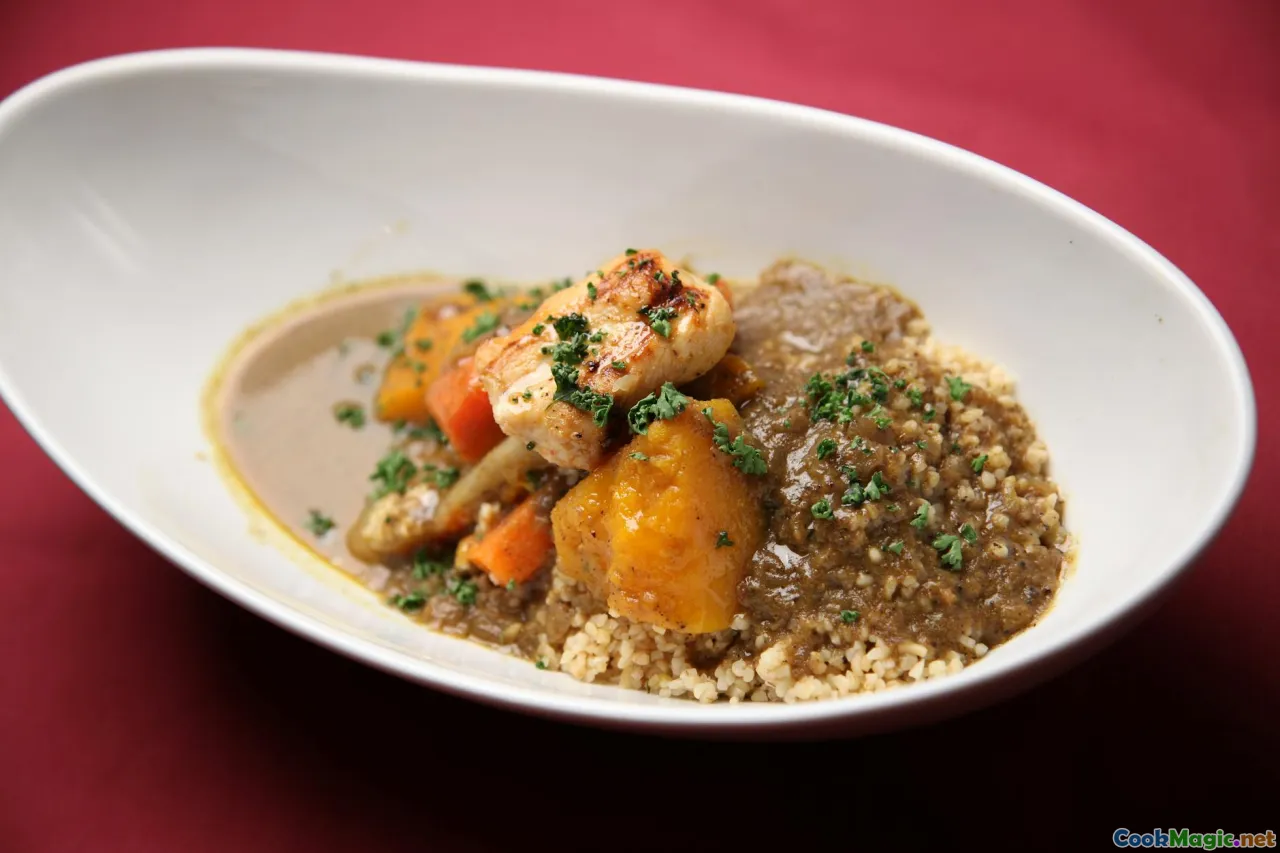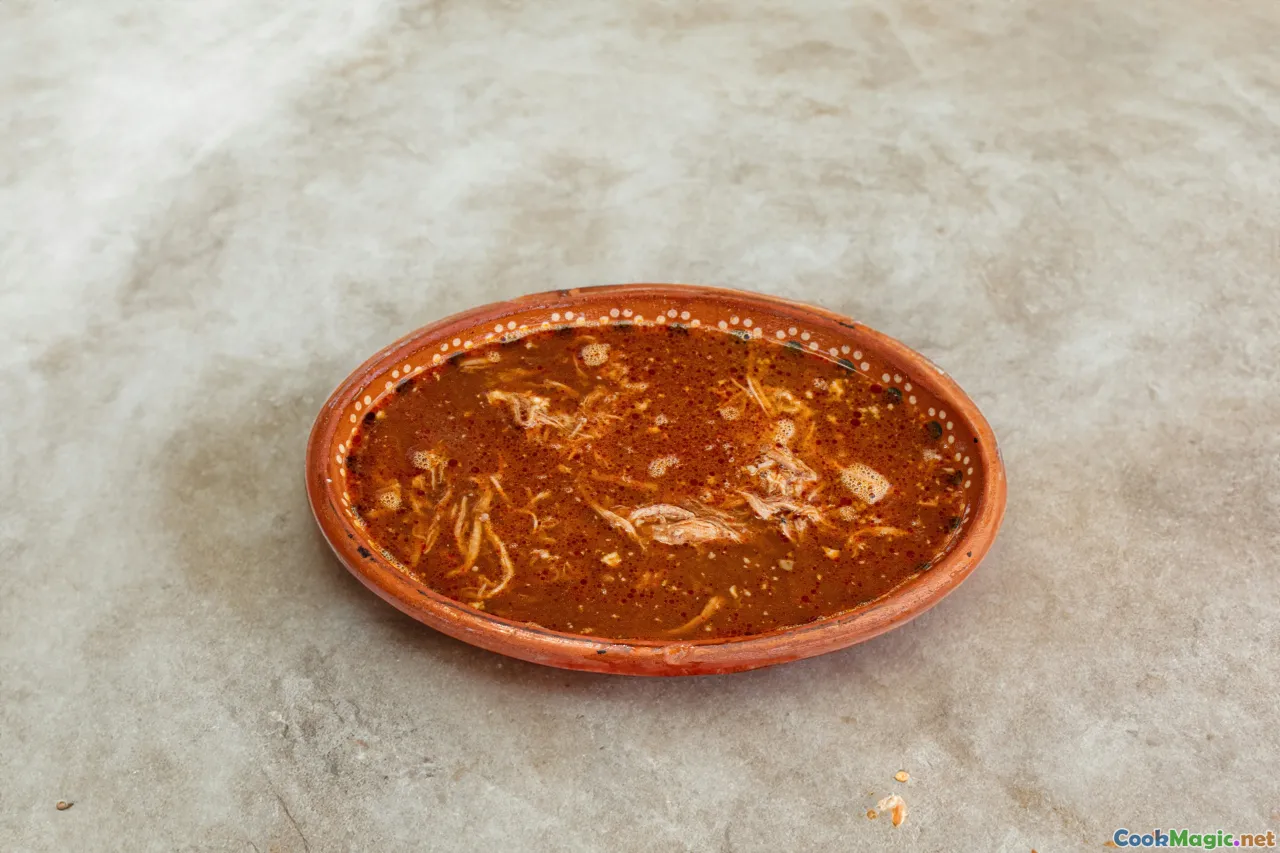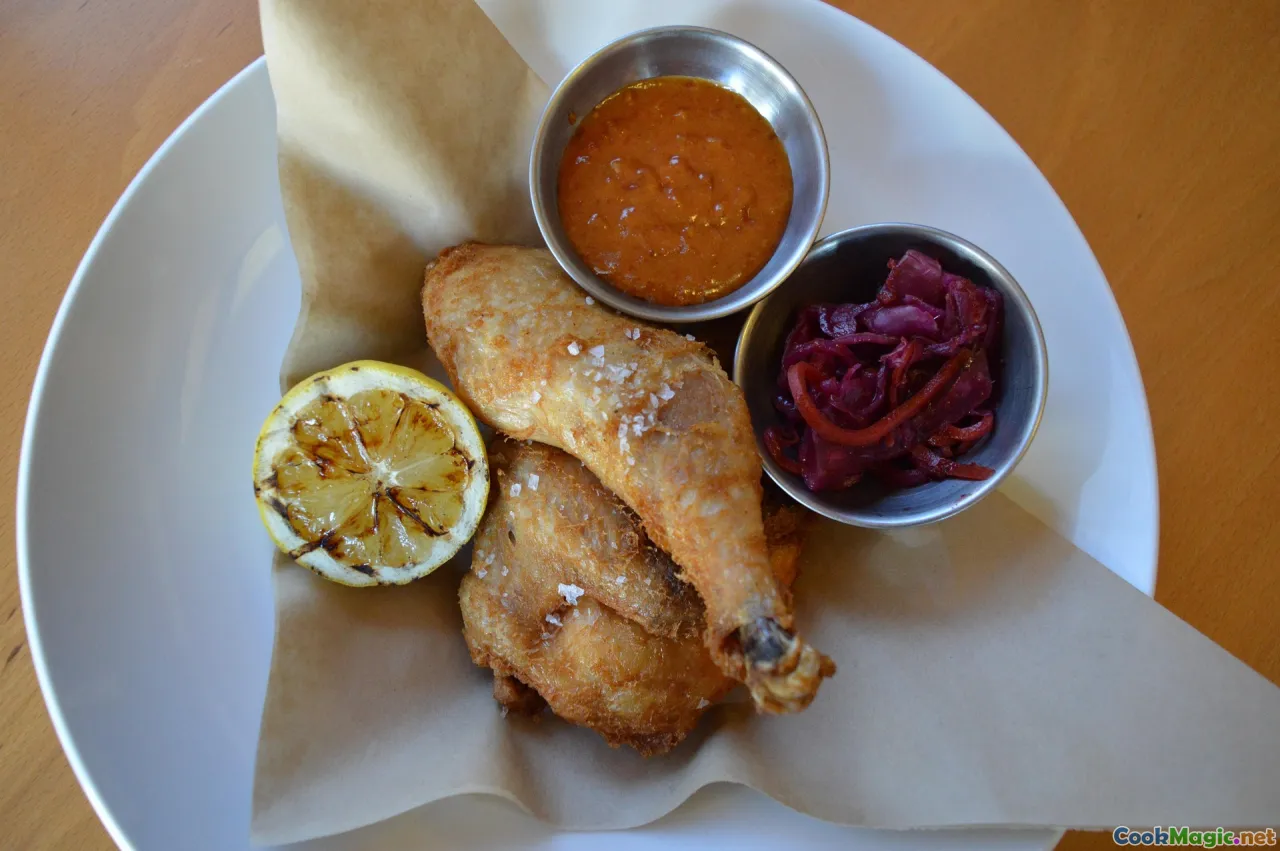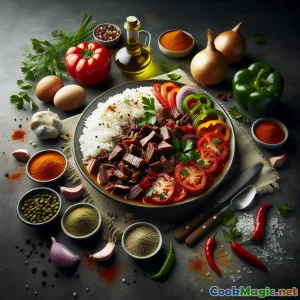
Słoneczne Gulasz z Orzeszkami Ziemnymi – Cazuela z Orzeszkami Ziemnymi Cruceña
(Sunshine Peanut Stew – Cazuela de Maní Cruceña)
(0 Recenzje)0
3,224
sierpień 26, 2025
Zgłoś problem
Składniki
-
4 pieces Udka z kurczaka bez skóry i z kością
(Can substitute with chicken breast for leaner version)
-
120 grams Surowe orzeszki ziemne (bez soli, obrane)
(Roast lightly for deeper flavor)
-
1 medium Cebula
(White or yellow)
-
3 large Ząbki czosnku
-
2 medium Pomidor
(Ripe, diced)
-
1 large Marchewka
(Pokrojony)
-
2 medium Ziemniak
(Peeled, cut into chunks)
-
1 medium Czerwona papryka
(Julienne)
-
1 tsp Kmin mielony
-
1/2 tsp Słodka papryka
-
1/2 tsp Proszek z achiote (annatto)
(Traditional Bolivian coloring & flavor)
-
2 tbsp Olej roślinny
-
1 liter rosół z kurczaka
(Zalecana niska zawartość sodu)
-
3 tbsp Świeża kolendra
(Posiekane, plus trochę więcej do dekoracji)
-
1 tsp Sól
(Do smaku)
-
1/2 tsp Świeżo zmielony czarny pieprz
(Do smaku)
-
1 tbsp Ají amarillo (żółta pasta z chili)
(Optional but authentic for heat & color)
-
80 grams Zielony groszek
(Can use frozen, add near end)
-
4 small portions Ryż na parze
(For serving; plays traditional role)
(Can substitute with chicken breast for leaner version)
(Roast lightly for deeper flavor)
(White or yellow)
(Ripe, diced)
(Pokrojony)
(Peeled, cut into chunks)
(Julienne)
(Traditional Bolivian coloring & flavor)
(Zalecana niska zawartość sodu)
(Posiekane, plus trochę więcej do dekoracji)
(Do smaku)
(Do smaku)
(Optional but authentic for heat & color)
(Can use frozen, add near end)
(For serving; plays traditional role)
Wartości odżywcze
- Porcje: 4
- Wielkość porcji: 1 głęboka miska (350 g)
- Calories: 550 kcal
- Carbohydrates: 35 g
- Protein: 32 g
- Fat: 30 g
- Fiber: 7 g
- Sugar: 6 g
- Sodium: 970 mg
- Cholesterol: 95 mg
- Calcium: 75 mg
- Iron: 3.4 mg
Instrukcje
-
1 - Toast and Grind Peanuts:
In a dry skillet over medium heat, toast raw peanuts, stirring often, until golden and fragrant. Let cool, then grind into a fine powder or paste using a food processor or mortar and pestle.
-
2 - Build the Sofrito Base:
Heat oil in a large pot over medium heat. Sauté chopped onions until translucent. Add minced garlic and cook for 2 more minutes. Stir in diced tomatoes, cumin, paprika, and optional achiote. Cook until tomatoes begin to soften.
-
3 - Brown the Chicken:
Add chicken thighs and cook, turning, until lightly golden on all sides but not fully cooked through.
-
4 - Simmer with Broth:
Pour in chicken stock and bring to a simmer. Add carrots, potatoes, and bell pepper. Stir in ground peanuts. Cover partially and simmer on gentle heat for 30 minutes, or until chicken and vegetables are tender. If using, add ají amarillo paste for depth and heat.
-
5 - Finish the Stew:
Add green peas (if using) for the last 5 minutes of cooking. Season stew with salt, pepper, and fresh chopped cilantro. Taste and adjust.
-
6 - Serve Warm:
Ladle the cazuela into deep bowls, garnish with additional cilantro. Traditionally accompanied by steamed rice on the side, or a wedge of lime for brightness.
In a dry skillet over medium heat, toast raw peanuts, stirring often, until golden and fragrant. Let cool, then grind into a fine powder or paste using a food processor or mortar and pestle.
Heat oil in a large pot over medium heat. Sauté chopped onions until translucent. Add minced garlic and cook for 2 more minutes. Stir in diced tomatoes, cumin, paprika, and optional achiote. Cook until tomatoes begin to soften.
Add chicken thighs and cook, turning, until lightly golden on all sides but not fully cooked through.
Pour in chicken stock and bring to a simmer. Add carrots, potatoes, and bell pepper. Stir in ground peanuts. Cover partially and simmer on gentle heat for 30 minutes, or until chicken and vegetables are tender. If using, add ají amarillo paste for depth and heat.
Add green peas (if using) for the last 5 minutes of cooking. Season stew with salt, pepper, and fresh chopped cilantro. Taste and adjust.
Ladle the cazuela into deep bowls, garnish with additional cilantro. Traditionally accompanied by steamed rice on the side, or a wedge of lime for brightness.
Więcej o: Słoneczne Gulasz z Orzeszkami Ziemnymi – Cazuela z Orzeszkami Ziemnymi Cruceña
Cazuela de Maní Cruceña – Golden Peanut Stew of Bolivia
Bolivia’s cities and fields boast a structural relationship to food—both layered by the country’s Quechua, Aymara, and European-influenced ingredients and flavors. If you’re searching for boldness, warmth, and a sense of homecoming in a bowl, Cazuela de Maní Cruceña is for you. With its base in rich, toasted peanuts and traceable threads of cinnamon-like annatto (achiote), the hearty chicken, and a vibrant tapestry of local vegetables, this stew is layered, comforting, and undeniably unique.
Historical/Cultural Background
Maní is the Spanish word for peanut, and the history of peanuts in Bolivia dates back thousands of years to the ancient indigenous cultures of the Andes and Amazon basin. As a staple protein—especially valuable before modern refrigeration—peanuts became a uniting ingredient among Bolivia’s eastern lowlands, particularly the Cruceño people of Santa Cruz. Over time, the blending of Spanish technique (such as the sofrito and the inclusion of paprika) with indigenous ingredients resulted in nostalgic dishes now considered timeless.
Peanut stew is a culinary celebration of the earth and its produce. It’s warm, inviting, and symbolizes abundance and enjoyment during communal and family gatherings.
Flavor & Unique Elements
What sets Cazuela de Maní Cruceña apart? At its heart, the delicate peanut paste fills the stew with both body and flavor—a luxurious mouthfeel enhanced by potato and carrot starches. Traditional touches of ground cumin, mild chili paste (ají amarillo), and fresh cilantro deliver bright, herbal, and slightly smoky notes.
Garnishes and visual appeal matter: that gleaming orange color, produced by achiote and paprika; the glint of cilantro; and the glowing green of peas delight the eye, telling the story of a Bolivian field in autumn.
Many Bolivians insist on integrating chopped potatoes and using bone-in chicken for deeper flavor. Optional green peas add color and sweetness, while a side of rice helps soak up the satiny broth.
Tips & Techniques
- Always toast peanuts to unlock their aromatics and oils.
- Grind the peanuts as fine as possible for smoothness—lumpiness can lead to separation in the stew.
- Bone-in chicken is more authentic, but boneless is easier!
- Adjust heat with chili paste to your taste. For low heat, skip ají amarillo, or add just a touch.
Adaptability
Vegetarians and vegans can build a similar body and flavor profile using mushrooms, sweet potato, and, of course, vegetable or mushroom stock. The stew is naturally gluten-free, and substituting tofu or jackfruit for chicken brings equally satisfying results.
Serving & Storage
Always allow Cazuela de Maní to rest at least five minutes before serving to mature the flavors. As tradition dictates, a bowl of fluffy rice goes alongside, but you can also enjoy it with rustic bread – especially if sharing family-style. Leftovers keep well for 2–3 days in the refrigerator, deepening in flavor after each day.
Personal Thoughts
While globally known peanut stews exist throughout West Africa and Asia, Bolivian Cazuela de Maní is truly distinctive for its use of indigenous herbs, local vegetables, and typical tenderness derived from eastern Bolivian cooking. Every spoonful returns a memory—sun-lit Andean afternoons or bustling family lunches. I find home in its golden soup, spirited spices, and the elegant finish left by fresh cilantro.
Final Remark
Dive into this traditional dish and taste the earthiness and inventiveness that Bolivians, especially Cruceños, have fostered for generations. Compassionate, robust, and easy to love—a genuine treasure served best with friends or family under the warm sun.



















